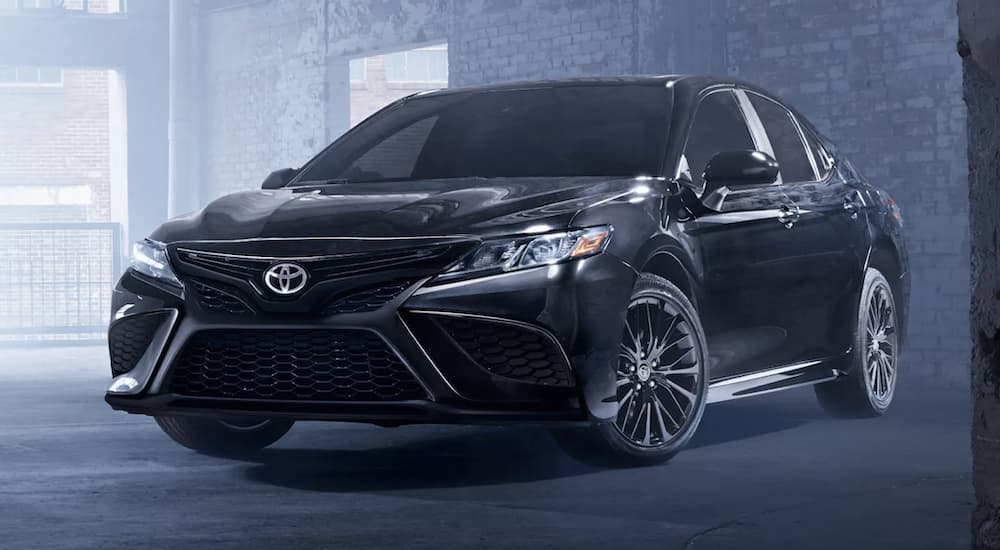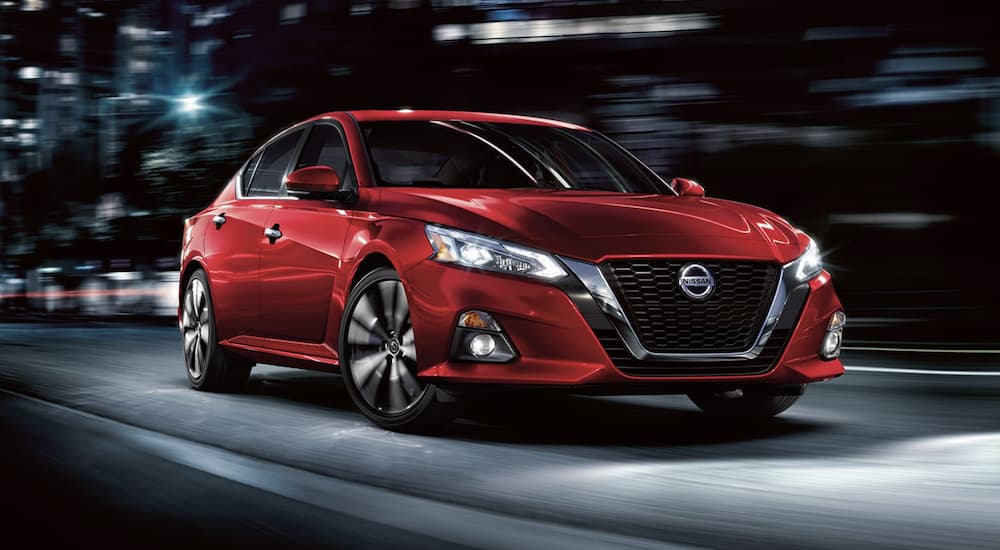Once upon a time, the most popular model of car was the midsize sedan. These fuel-efficient family cars provided just enough room for up to 5 passengers and were easy for most folks to drive. Two of the best in this category are the 2022 Nissan Altima vs 2022 Toyota Camry. However, in recent years, the midsize sedan has been overtaken by the SUV and pickup truck as the most popular models.
Today, of the top five best-selling vehicles in America, the first three are pickup trucks, followed by two SUVs. The days of the sedan seemed numbered. However, the recent spike in inflation has distinctly affected gas prices, renewing interest in more fuel-efficient models.
The Altima and Camry are two of the longest-running midsize sedans in this vehicle class. The Altima was introduced to American drivers in 1993 and has continued to rule the roads for six successful generations. The Camry is an even older model, dating back to 1983. Now in its eighth generation, the Camry evolved from a narrow-bodied model that was almost a compact model to a more robust, midsize sedan.
The key to the successful legacy for both the Nissan Altima and Toyota Camry is a fuel-efficient, dependable powertrain. This is why both Nissan and Toyota have continued to build their respective midsize sedans while most of their competitors have decided to focus on SUVs and pickup trucks. With gas prices spiking nationwide, I wonder if these competitors are re-thinking their decision to focus solely on larger, less fuel-efficient models?

Powertrain Comparison
Both Nissan and Toyota have chosen to give drivers a choice of two different engines with one standard transmission on their respective vehicles. Interestingly enough, the base engine on the 2022 Nissan Altima and the 2022 Toyota Camry are practically identical in size, displacement, and design. The 2022 Nissan Altima features a 2.5-L PR2DD I-4 base gas engine. This features an aluminum block and aluminum cylinder heads in a dual overhead-cam (DOHC) configuration with 4 valves per cylinder. The 2.5-L engine has a 2,488 cc displacement and uses direct fuel injection to provide up to 188 horsepower at 6,000 rpm and 180 lb-ft of torque at 3600 rpm—on front-wheel drive models. Choosing all-wheel drive reduces these figures slightly to 182 horsepower at 6000 rpm and 178 lb-ft of torque at 3600 rpm.
The base engine on the 2022 Toyota Camry is also a 2.5-L I-4 gas engine. This also features an aluminum alloy engine block with aluminum alloy heads in a DOHC configuration with direct fuel injection. The displacement is slightly less, 2,487 cc. Nevertheless, this engine will deliver 203-206 horsepower at 6600 rpm and 182-186 lb-ft of torque at 4400-5000 rpm, depending on which Camry model and drivetrain you choose.
The 2022 Nissan Altima and 2022 Toyota Camry feature a more powerful engine option. However, where the Altima goes for adding a turbocharger to a 4-cylinder engine, Camry opts for a 6-cylinder engine upgrade. The 2022 Altima has an available 2.0-L KR20DDET VC-Turbo I-4 gas engine. This also has an aluminum block and heads in a DOHC configuration. However, in addition to the turbocharger, this engine also features a combination of direct and port fuel injection.
As a result, despite only having a 1,970 to 1,997 cc displacement, the 2022 Altima is capable of delivering 236 horsepower at 5600 rpm and 267 lb-ft of torque at 4000 rpm. These figures can increase to 248 horsepower and 273 lb-ft of torque if you choose to use 93-octane gas instead of 87-octane.
The optional engine on the 2022 Camry is a 3.5-L V6. This engine has a DOHC configuration with aluminum alloy block and heads, but 24-valves instead of the 16-valves on the smaller 4-cylinder engines on the Altima and Camry. As a result, it has a 3,456 cc displacement and is capable of producing 301 horsepower at 6600 rpm and 267 lb-ft of torque at 4700 rpm. While that is more horsepower than on the optional VC-Turbo engine on the Altima, it can’t match the torque output on the Altima with that available engine.
Nissan has gone with an Xtronic CVT on all models of the 2022 Altima, which stands for continuously variable transmission. The models with the VC-Turbo engine add paddle shifters for greater driver input. In contrast, Toyota has equipped every 2022 Camry with a Direct Shift 8-speed ECT-I automatic transmission with sequential shift mode.
The key difference between a CVT and an automatic transmission is that the CVT replaces the gears on an automatic transmission with a pulley system. This allows the transmission to constantly change its gear ratio while driving to better match engine speed to performance. As a result, cars with a CVT tend to be more efficient than ones with automatic transmissions. However, some drivers prefer an automatic transmission as it gives them a sportier feel as the engine shifts through the different gears.
Fuel Economy Comparison
If you are concerned about fuel economy, then the 2022 Nissan Altima and 2022 Toyota Camry will not disappoint you in this regard. If you choose either model with the base 2.5-L I-4 gas engine and front-wheel drive, you will probably get the same gas mileage figures. The base models of the 2022 Altima and 2022 Camry provide up to 28 MPG in city driving, 39 MPG on the highway, and 32 MPG combined. These are the top figures for either model, which is why the base models may be the best for drivers looking for an affordable commuter car. If you go with a higher trim in either car, you will see the fuel economy figures drop slightly to 27 MPG in the city, 37 MPG on the highway, and 31 MPG combined.
This identical fuel economy between the Altima and Camry changes if you choose to go with all-wheel drive on the base 2.5-L I-4 engine. The all-wheel drive Altima delivers 26 MPG in city driving, 36 MPG in highway driving, and 30 MPG combined—compared to only 25 MPG in the city, 34 MPG on the highway, and combined 29 MPG with the all-wheel drive Camry.
This difference is also apparent in the optional engines on the 2022 Altima and 2022 Camry. By going with a turbocharger on the available 2.0-L VC-Turbo I-4, the Altima is able to give you a very impressive 25 MPG in the city, 34 MPG on the highway, and 29 MPG combined. This easily eclipses the 22 MPG in city driving, 33 MPG on the highway, and 26 MPG from the 2022 Camry with the available 3.5-L V6 engine.
Interestingly, Nissan and Toyota only offer these engines on models with front-wheel drive. Nevertheless, the 2022 Toyota Camry with this available engine is going to cost more with respect to gasoline than the 2022 Nissan Altima with the available turbocharged I-4.

Performance Comparison
The 2022 Nissan Altima with the base engine is slightly faster than the 2022 Toyota Camry with its base engine, as the Altima can go from 0 to 60 miles per hour in just 7.4 seconds—while the Camry needs 7.5 seconds to cover the same ground. The Altima with the available VC-Turbo engine easily exceeds these figures, zooming from 0 to 60 miles per hour in just 5.8 seconds. However, the Camry with the optional 3.5-L V6 is the fastest of the four, going from 0 to 60 miles per hour in 5.1 seconds. It’s clear that by going with a V6 engine, Toyota has decided to put performance ahead of fuel economy on the Camry.
Running on Empty, Running Blind
To paraphrase Jackson Browne, you could be running on empty pretty soon if you don’t pay attention to your car’s fuel economy figures. You could be running into the sun, but pretty soon you’ll be running behind. This is why it is vital to choose a fuel-efficient vehicle like a 2022 Nissan Altima or a 2022 Toyota Camry if you are going to stay ahead of rising fuel prices. Still, comparing the two, while the Camry delivers solid fuel economy as well as exceptional performance with its available V6 gas engine, the 2022 Altima delivers better fuel economy across all platforms.




